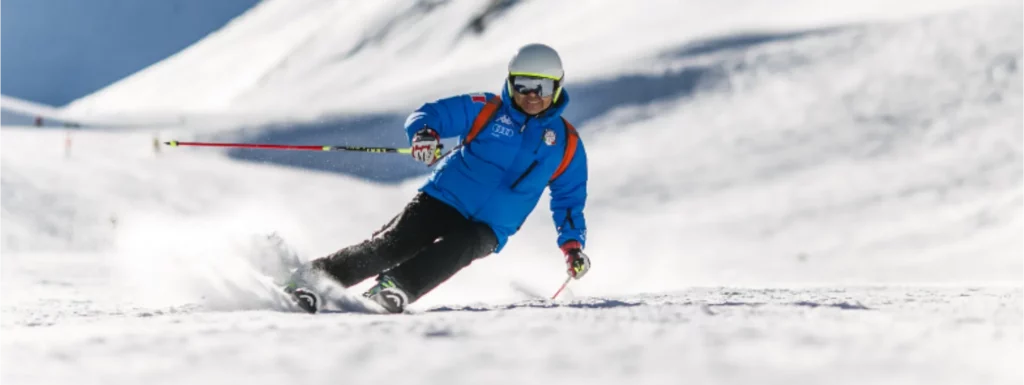Are you heading off on a skiing / boarding trip soon? If the answer’s yes, then check out these top ski trip tips on how to avoid injury on the slopes.
Winter sports like skiing and snowboarding provide a high like no other. However, if you’re not careful on the slopes and don’t prepare before you go, you could end up with unnecessary aches, pains and injuries that could spoil your fun.
Common injuries
Lower back pain is the most common form of ski-related pain due to the stress placed on the spinal vertebrae, joints, and soft tissues that support the spine. Tightness and inflammation as a result of a long day on the slopes are also common, while wipeouts can cause muscle or ligament strain. The risk of these can be minimised though by following these tips.
Pre ski trip tips
Unless you’re lucky enough to live near a ski resort, skiing and snowboarding are not sports we tend to do regularly. As with any sport you’re new to or don’t do regularly, if you don’t prepare in advance or give your body time to adjust, it’s more likely you’ll end up with an injury as a result. See below for our top ski trip tips on how to best prepare before you go.
- Get fit – Ideally you should start getting fit at least six weeks before your trip, but it’s never too late to start building up fitness. Any preparation you do will put you in good stead, so if you haven’t started yet, get working on your cardio fitness as soon as you can.
- Work your muscles – Injury free skiing starts with a strong body. In addition to cardio fitness, start exercising the muscles that are going to get a daily work out on the slopes too. Work on strengthening the muscles that get worked the most, including your core, quads, glutes, hamstrings and hips. Use a mini trampoline to build up fitness while also working all those ‘skiing’ muscles. For a 20 minute at home pre skiing workout from Skiclub.co.uk, click here.
- Get flexible – Skiing with muscle stiffness or a lack of flexibility might increase your risk of a pulled muscle or torn ligament. Get stretching those muscles and increasing your flexibility in advance.
- Work on your balance – Balance is a key skill required for skiing and snowboarding. Use a wobble board to improve balance and build up ankle muscles. For a thorough ankle work-out, rocking heel to toe is good for snowboarders, while left to right is best for skiers.
- Get match fit – Getting a check up with a chiropractor or osteopath before you hit the slopes is a great way to make sure your body is in good working order before you put it through its paces on the slopes.
Tips for on the slopes
Preparation is key, but you can also help reduce your risk of aches, pains and injury while on the slopes with these tips below:
- Stretch it out – Hopefully you’ve got great flexibility from all the stretches you did back at home, but make sure you get a good stretching session in at the start and the end of each day too.
- Warm up – Start off gently rather than heading straight for the black runs and always take one warm-up run down the easiest run before beginning skiing on more challenging terrain.
- Ski safe – Don’t push yourself too hard – ski on slopes that fit your ability level.
- Give yourself a break – Listen to your body and take plenty of breaks, especially if you’re feeling tired or are in pain. Pain is your body’s warning sign, so don’t ignore it.
- Pace yourself – Don’t assume that an injury is most likely to happen at the start of your trip. Often, injury comes later on, when your confidence has grown but your muscles are tired and your body isn’t able to keep up with what you think you’re capable of.
- Use ice – With an acute injury, use ice rather than heat. Ice any painful areas following each day of skiing.
Equipment tips
Having the right equipment and knowing how to use it will also help reduce your risk of injury – see tips below:
- Get the right equipment – Choose a hire shop with a wide range of boots and take the time to get boots that fit properly. This will help you ski / snowboard with more control. If you are prone to going ‘knock-kneed’ when you ski, mention this at the rental shop, as wedges placed under the binding can make a huge difference. And if you own your own equipment, make sure it’s still fit for purpose.
- Carrying your equipment – Carrying heavy skis, boots and other equipment awkwardly can lead to aches and pains. Ask the staff at the rental shops how best to carry the equipment to avoid unnecessary strains on the slopes. Leave them standing upright so you don’t have to bend to pick them up and carry them over your shoulder, swapping shoulders regularly.
Pre holiday check ups
We hope this blog helps you have a happy holiday but if you want to book in for a pre holiday check up to make sure you’re ready for action before you go, or a post holiday treatment if you’ve picked up any injuries on the piste, please just give us a call on 0117 972 3518.
